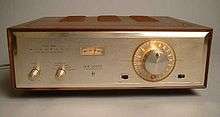H. H. Scott, Inc.
H. H. Scott, Inc. was a major manufacturer of hi-fi equipment in the U.S. It was founded in 1947 by Hermon Hosmer Scott in Cambridge, Massachusetts and moved to Maynard, Mass in 1957.[1]
History
H.H. Scott sold some of the earliest FM stereo multiplex tuners and receivers, with some units sold as kits. The company's competition included brands like Fisher, Marantz, McIntosh, and Harman Kardon. In 1958, H.H. Scott introduced the first true stereophonic receiver, which used a stereo multiplex decoder. The 1961 Model 350 was the first FM stereo multiplex tuner sold in the US. H.H. Scott was involved in early stereo multiplex testing with radio station WCRB in Boston, one of the first three U.S. FM stations to broadcast in multiplex stereo.
"Lacking the capital needed to continue operations, Scott terminated its production in October 1972. In November 1972, several of Scott's creditors filed a petition for involuntary bankruptcy under Chapter X of the Bankruptcy Act, and Scott filed a petition for reorganization under Chapter XI of the Bankruptcy Act. In the same month, Eastern Air Devices released its option to acquire the company. In January 1973, however, the Scott company was acquired by SYMA International, Brussels, Belgium, Scott's European licensee." "Production at Maynard was resumed in February 1973."[2]
Per NYT obit, Hermon Scott retired in 1972. Per Audio Eng Society obit, Technical Director Daniel Von Reckinghausen was appointed staff consultant at Electro Audio Dynamics (formerly Eastern Air Devices) in 1973.
Between late 1975 and late 1976, the company's operations moved from Maynard to Woburn, Mass.[3]
In 1985, the brand was purchased by Emerson Electronics.[4][5]
 1956 Model 311-B Mono FM Tuner
1956 Model 311-B Mono FM Tuner- 1956 Model 311-B Top View of the tubes
 1961 Model 350A FM Multiplex Stereo Tube Tuner - The First FM Multiplex Stereo Tuner on the US market
1961 Model 350A FM Multiplex Stereo Tube Tuner - The First FM Multiplex Stereo Tuner on the US market 1964 Model LK-72 B 80 Watt Stereo Tube Integrated Amplifier—sold in kit form
1964 Model LK-72 B 80 Watt Stereo Tube Integrated Amplifier—sold in kit form TOP VIEW 1964 Model LK-72 B 80 Watt Stereo Tube Integrated Amplifier
TOP VIEW 1964 Model LK-72 B 80 Watt Stereo Tube Integrated Amplifier- Rare HH Scott LT-111 FM Stereo Tube Kit Tuner Utilizing Compactron Tubes c. 1965
- LT-111 Top Chassis View
- Rare HH Scott Model 350 Tube FM Multiplex Tuner with dealer installed Marantz faceplate.
- Rare HH Scott Model 350 Tube FM Multiplex Tuner (Marantz Font View) with dealer installed Marantz faceplate.
E.H. Scott
E.H. Scott Radio Laboratories is sometimes confused with H.H. Scott. E.H. Scott was founded in 1925 by Chicago resident Ernest H. Scott. The company motto was "The Fine Things Are Always Made by Hand". The company was also known as Scott Radio Laboratories, and went through many changes of ownership until its eventual merge with John Meck in the 1950s. Known for its elaborate, high quality radio receivers, the company had no connection to H. H. Scott. The company published news of its latest developments in monthly "The Scott News" from 1929 to 1946.[6] In later years, HH Scott filed a lawsuit ending the use of the Scott Radio Laboratories name.[7][8][9][10][11]
See also

References
- Powder Mill Realty Trust v. Commissionner Docket No. 2955-71 U.S. Tax Court Filed July 9, 1973
- U.S. Tariff Commission, Solid State Receivers ... Workers of H. H. Scott, Report to the President on Investigation No. TEA-W-189, May 1973
- Advertisements: Nov 1975, p 119, Stereo Review and Oct 1976, p 5, Audio.
- Thom Holmes (18 October 2013), The Routledge Guide to Music Technology, Taylor & Francis, pp. 314–, ISBN 978-1-135-47787-5
- Michael Czinkota; IIkka Ronkainen (1 November 2009), Emerging Trends, Threats and Opportunities in International Marketing: What Executives Need to Know, Business Expert Press, pp. 271–, ISBN 978-1-60649-036-5
- "Scott News". Worldradiohistory.com. American Radio History. Retrieved 27 June 2020.
- Slusser, John. "Book Review - The Making of a Scott Second Edition, Opportunity of a Lifetime". Antique Radio Classified. Vintage Radio Publishing. Retrieved 3 June 2019.
- John Slusser (September 2002). E. H. Scott - the Dean of DX: A History of Classic Radios. Radio Daze, LLC. ISBN 978-0-9723301-0-7.
- Alan Douglas (February 1999). Radio Manufacturers of the 1920s, Volume 3. Sonoran Publishing. pp. 73–. ISBN 978-1-886606-04-3.
- Puett, J. W. F. "Antique Radio's Touch of Perfection". Vintage HHScott Hi-Fi Stereo Archive. Lee K. Shuster. Retrieved 27 June 2020.
- Stosich, Michael N. ""Nothing New Under the AM Sun"". Vintage HHScott Hi-Fi Stereo Archive. Lee K. Shuster.
Originally published in the January, 1977, issue of Audio (magazine)